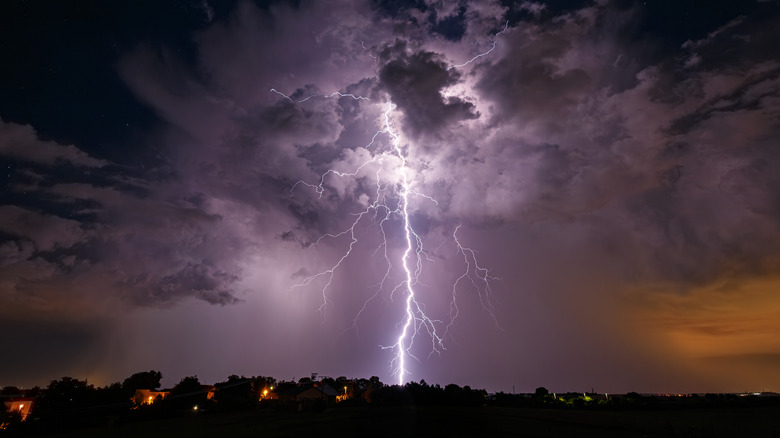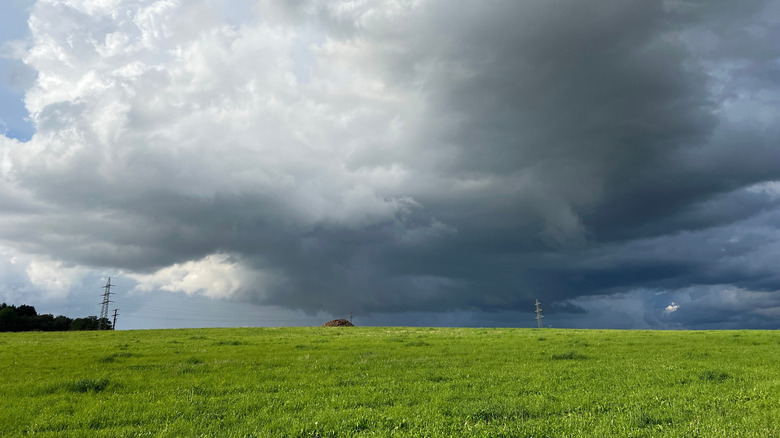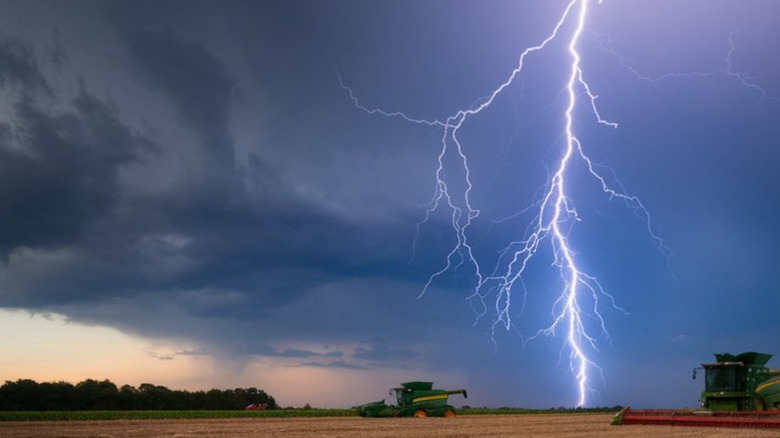The Warning Sign That Lightning Might Be About To Strike
A thunderstorm is one of nature's most dramatic acts, and one of its most frightening. All thunderstorms produce lightning, every bolt of which releases around 1 billion joules worth of energy. That's enough to keep a 60-watt light bulb on for over six months. Lightning is so powerful that it heats the air around it to 50,000 degrees Fahrenheit, five times greater than the surface temperature of the sun. It's no wonder that so many ancient faiths interpreted lightning as the wrath of a god.
Despite this awesome power, thunderstorms are healthy for the planet. Lightning helps grass grow, aids in ozone production, and helps to maintain the electrical balance of the atmosphere. However, it can be very dangerous to humans. A lightning strike can trigger cardiac arrest, paralyze the respiratory system, and make a person's eardrums explode. Around 10% of people who get struck by lightning are killed on the spot, while the 90% who survive frequently face lifelong consequences in the form of severe burns, nerve damage, concussion-like symptoms, and post-traumatic stress disorder.
To keep yourself and your loved ones safe from the dangers of lightning, pay attention to your hair. That's right, the hairs on your head and arms can be a good indicator of whether lightning is inbound. If your hairs start standing on end, it could mean an electrical charge is building up in the air, like the effects of static electricity in the body. This is a clear sign to run for safety, but it's not the only way to protect yourself from lightning.
Other ways to tell when a thunderstorm is coming
You can use all five of your basic senses — sight, hearing, touch, taste, and smell — to tell when lightning is about to strike. The main visual sign you should watch out for is the approach of storm clouds. Lightning is only produced by cumulonimbus clouds, which have a dense and fluffy appearance. These clouds hang low to the ground but are also very tall, reaching high into the sky before flattening out at the top like an anvil. Cumulonimbus clouds may look beautiful on a sunny day, but if you see them when the sky is gray, be wary. Keep your ears peeled for peals of thunder as well. Thunder comes in multiple forms, mainly rolling and clap thunder, and these sounds mean that lightning is nearby.
Believe it or not, you can also taste and smell an approaching thunderstorm. If you're outside and you suddenly sense a metallic taste in your mouth, it means there is an electrical current in the air. You may also catch a whiff of something that smells a bit like chlorine, but it's actually ozone. Most of the oxygen in the atmosphere exists in paired form (O₂), but lightning is powerful enough to split these pairs apart, and in the aftermath, some of the loose oxygen atoms group together in threes to form ozone (O₃). If you smell ozone in the air, it means lightning has already been active.
What to do if lightning is about to strike
If you sense any of the warning signs of lightning, you need to take immediate action to protect yourself. Your top priority should be finding shelter, ideally in a sturdy building. If you happen to be driving at the time, your car can actually protect you from lightning, as long as it's not a convertible. If you find yourself out in the open when lightning approaches and there is no shelter to be found anywhere, you need to find the lowest ground around and keep away from tall things like trees and poles, as well as conductive objects like power lines, fences, and bodies of water. The idea that lightning never strikes twice in the same place is a myth. Tall and conductive objects get hit repeatedly, making them very dangerous. Lastly, never lie down in a thunderstorm, as the ground can transfer electrical currents as well.
Even indoors, you aren't entirely safe from lightning. Roughly one-third of all lightning-induced injuries actually happen inside. That's because the water and electronic equipment inside buildings can still conduct electricity. If there's a thunderstorm happening outside, you should refrain from using the sink, shower, or bath and keep your hands off of any electronics that are plugged into the wall, but wireless electronics are still safe to use. When the storm finally passes, wait until there have been no signs of lightning for at least half an hour before resuming normal activities.


